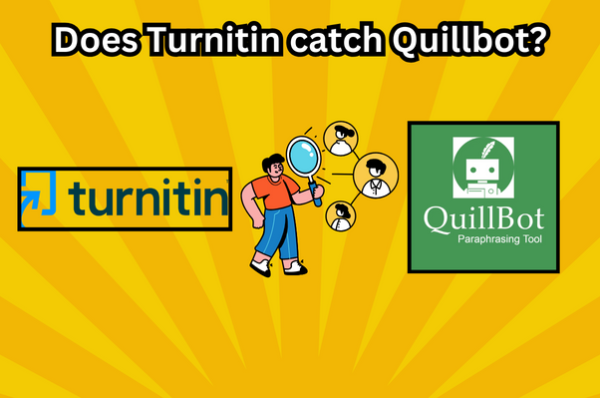Contents
- 1 Can Quillbot Be Detected by Turnitin? Unraveling the Mystery
- 1.1 Understanding Quillbot and Its Functionality
- 1.2 Turnitin’s Plagiarism Detection Capabilities
- 1.3 The Detection Conundrum: Quillbot vs. Turnitin
- 1.4 Factors Influencing Detection
- 1.5 Ethical Considerations in Academic Writing
- 1.6 Best Practices for Students and Educators
- 1.7 The Future of AI Writing and Plagiarism Detection
- 1.8 Conclusion: Navigating the Gray Area
- 1.9 10 FAQs About Quillbot and Turnitin and Their Answers
- 2 Exploring Turnitin Alternatives: Safeguarding Academic Integrity
- 3 How old is Quillbot
- 4 The Age and Evolution of Quillbot
Can Quillbot Be Detected by Turnitin? Unraveling the Mystery

In the digital age of academia, students and educators are increasingly grappling with a crucial question: Can Quillbot be detected by Turnitin? This inquiry sits at the crossroads of AI-powered writing assistance and plagiarism detection, sparking debates about academic integrity and the evolving nature of educational technologies.
Understanding Quillbot and Its Functionality
Quillbot has emerged as a popular AI-powered paraphrasing tool. It offers users the ability to rephrase text while attempting to preserve the original meaning. Many students turn to Quillbot to enhance their writing or to reword source material. However, its usage raises ethical concerns and questions about academic honesty.
Turnitin’s Plagiarism Detection Capabilities
Turnitin stands as a cornerstone in plagiarism detection for educational institutions worldwide. It operates by comparing submitted work against an extensive database of sources, including academic papers, websites, and previously submitted student work. The question of whether Quillbot can be detected by Turnitin hinges on understanding the capabilities and limitations of both technologies.
The Detection Conundrum: Quillbot vs. Turnitin
The straightforward answer to “Can Quillbot be detected by Turnitin?” is not simple. While Turnitin doesn’t claim to directly detect AI-generated content, it’s designed to identify similarities with existing sources. This means that if Quillbot produces text that closely resembles original sources, Turnitin might flag it as potential plagiarism.
Factors Influencing Detection
Several elements play a role in determining whether Quillbot-generated content might trigger Turnitin‘s detection:
- Similarity to original sources
- Degree of paraphrasing
- Uniqueness of the generated content
- Integration with original ideas and arguments
Ethical Considerations in Academic Writing

Beyond the technical aspects of detection, the use of Quillbot raises significant ethical questions. Academic institutions value original thought, proper citation, and the development of critical thinking skills. Overreliance on AI tools like Quillbot may compromise these fundamental aspects of education.
Best Practices for Students and Educators
To navigate the complexities surrounding Quillbot and Turnitin, consider these guidelines:
- Use AI writing tools responsibly and sparingly
- Always provide proper citations for sources
- Focus on developing original ideas and arguments
- Consult with instructors about the acceptable use of writing aids
The Future of AI Writing and Plagiarism Detection
As AI technology continues to advance, the landscape of academic writing and plagiarism detection will undoubtedly evolve. Both Quillbot and Turnitin are likely to refine their capabilities, potentially leading to an ongoing technological race between writing aids and detection tools.
The question “Can Quillbot be detected by Turnitin?” doesn’t have a definitive yes or no answer. While Turnitin may not directly detect the use of Quillbot, it can flag content that resembles existing sources. Students and educators must approach these tools cautiously, prioritizing academic integrity and original thought above all else.
By understanding the intricacies of Quillbot, Turnitin, and their interaction, students and educators can make informed decisions about using AI writing tools in academic settings. The ultimate goal should always be to maintain academic integrity while fostering genuine learning and skill development.
10 FAQs About Quillbot and Turnitin and Their Answers

- How accurately can Turnitin identify Quillbot-generated text? Turnitin can’t directly identify Quillbot use but may flag similarities if the paraphrased text closely matches existing sources.
- Is using Quillbot considered a form of academic misconduct? Many institutions consider the uncited use of Quillbot as academic misconduct. Policies vary, so check with your school.
- What percentage of similarity typically triggers Turnitin’s detection? There’s no fixed percentage. Institutions set their own thresholds, often ranging from 15-25%.
- Are there settings in Quillbot to reduce detection likelihood? Quillbot offers various paraphrasing modes, but none guarantees avoiding detection.
- Can Turnitin distinguish between AI-generated and human-written text? Turnitin isn’t specifically designed to detect AI writing, but it can flag unnaturally paraphrased content.
- How often does Turnitin update its database to detect new sources? Turnitin updates its database continuously, adding new web content and submitting papers daily.
- Are there legal implications of using Quillbot for academic work? Legal issues are rare, but academic consequences can be severe if caught misusing Quillbot.
- Can professors tell if a student has used Quillbot in their writing? Experienced professors may notice inconsistencies in writing style or unnaturally paraphrased text.
- What alternatives to Quillbot are less likely to be flagged? Manual paraphrasing and original writing are always safest. No AI tool guarantees avoiding detection.
- How does Turnitin handle text that has been translated and paraphrased? Turnitin can detect some translated content, especially if it’s been translated back to the original language.
Exploring Turnitin Alternatives: Safeguarding Academic Integrity

In the ever-evolving landscape of academic integrity, Turnitin has long been a dominant force. However, educators and institutions are increasingly seeking Turnitin alternatives to diversify their plagiarism detection toolkit. This article delves into various options that serve as viable Turnitin alternatives, offering unique features and approaches to maintaining academic honesty.
Why Consider Turnitin Alternatives?
While Turnitin remains a popular choice, exploring Turnitin alternatives can provide several benefits:
- Cost-effectiveness
- Specialized features
- Different database coverage
- Enhanced user experience
Popular Turnitin Alternatives
1. PlagScan
PlagScan stands out among Turnitin alternatives for its user-friendly interface and comprehensive reporting. It offers:
- Multi-language support
- Integration with learning management systems
- Customizable sensitivity settings
2. Unicheck
As one of the rising Turnitin alternatives, Unicheck provides:
- Real-time similarity checking
- Citation detection
- Ability to exclude quoted text from similarity scores
3. Copyscape
While primarily known for web content, Copyscape has emerged as one of the notable Turnitin alternatives for its:
- Extensive web database
- Quick results
- Affordable pricing for individual use
Open-Source Turnitin Alternatives
For institutions seeking budget-friendly Turnitin alternatives, open-source options include:
- VeriCite
- PKP’s Plagiarism Detection Plugin
These Turnitin alternatives offer customizable solutions that can be tailored to specific institutional needs.
AI-Enhanced Turnitin Alternatives
As technology advances, some Turnitin alternatives are incorporating AI to enhance detection:
- Grammarly’s plagiarism checker
- ProWritingAid’s plagiarism tool
These tools not only check for plagiarism but also offer writing improvement suggestions.
Choosing the Right Turnitin Alternative
When selecting among Turnitin alternatives, consider:
- Database size and coverage
- Integration capabilities with existing systems
- Reporting features and ease of use
- Cost structure
- Support for multiple file formats
The Future of Plagiarism Detection
As Turnitin alternatives continue to evolve, we can expect:
- More sophisticated AI integration
- Improved detection of paraphrased content
- Enhanced cross-language plagiarism detection
Conclusion: Embracing Diversity in Plagiarism Detection
While Turnitin remains a strong player, exploring Turnitin alternatives can provide institutions with a more diverse and comprehensive approach to maintaining academic integrity. By understanding the strengths of various options, educators can choose the tool that best fits their specific needs and challenges.






